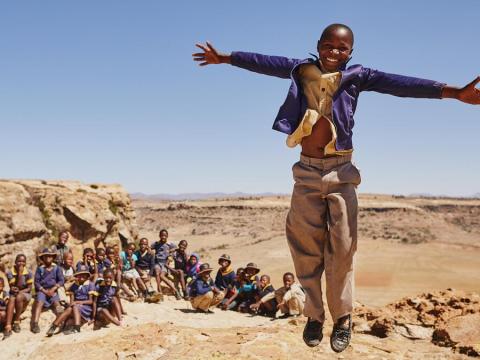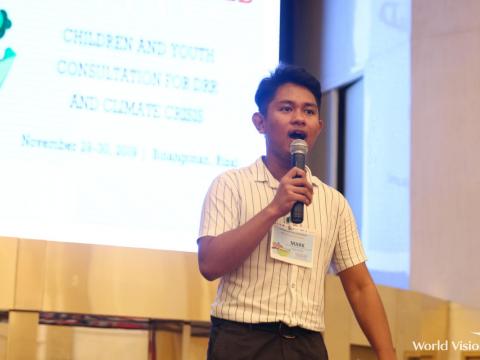
Five ways we honour the dignity of sponsored children
Graeme explains how World Vision works to respect children’s privacy and participation through sponsorship in an increasingly connected world
Graeme Newton, Senior Director, Child Sponsorship Marketing and Engagement
Human connection.
It’s the heartbeat of child sponsorship, a development approach that for over 70 years has given children and communities in poverty the tools they need to change their futures. It's a connection, initially formed through the sending and receiving of letters and photos, but it soon becomes much more.
When personal connection underpins decisions to invest in tackling poverty and injustice, and when empowering local people to enact local solutions is the goal, children and communities are considered partners with sponsors in development. Children aren’t hapless victims and sponsors aren’t saviours on a white horse – they are both allies, collaborators working together to correct generations of injustice, each making their own important contributions.
In all our communication materials, World Vision strives to portray children with dignity as co-authors of transformation who can contribute knowledge, ideas and motivation to bring about real development. While we do not hide the, often, devastating realities that sponsored children face, children are not framed as helpless victims or commodities to be exploited for the purposes of marketing – they are respected as co-authors of transformation, change agents with the knowledge, ideas and motivation needed to bring about real development. We love to celebrate their contribution, as well as the backgrounds and cultures in which they live and grow.
More recently, digital technology has meant that our sponsorship programme has been able to deepen this human connection between two people who will most likely never meet in person. As well as working hard to maintain dignity and authenticity in this virtual partnership, our staff members are also acutely aware that we do have a particular responsibility for protecting child data, child privacy and child consent. Protecting the vulnerable must always be our highest priority.
Here are five important ways we protect children, celebrate who they are, and ensure they are an integral part of our collective efforts to address poverty:
1. Choice is the bedrock of meaningful child development. Consent at every level - from programme participation to capturing photos and videos - is foundational to the integrity of child sponsorship and its outcomes. Whether a child’s family chooses for him or her to be part of the child sponsorship programme and everything that involves is entirely voluntary.
When a child’s carers do choose to register their child, there is a formal process to complete that includes giving informed, signed consent for their child to participate in World Vision activities and have their name and appropriate personal details, photos and videos taken and shared with a sponsor or in online and printed content.
2. Safeguarding is not left to chance. Enabling correspondence between sponsors and children is critical to a development model based on human connection. These exchanges also carry risks that need to be managed to ensure positive results for children.
Staff at World Vision’s national offices open and check every piece of correspondence between sponsors and sponsored children. Details that sponsors or children have included that could jeopardise their own safety, such as an address, are removed before the letter is shared. Content that has the potential to harm a child in any way, including messages that are inappropriate, or demean or disempower, are not sent on to the child, and can be referred on for further protective action where necessary.
3. Diversity is at the core. The goal of child sponsorship is to empower local people to develop local solutions, and almost all staff in our national offices are citizens of the country they are working in. There are World Vision child sponsorship programmes in over 1,250 communities in Latin America, the Caribbean, the Middle East, Eastern Europe, Africa and across Asia. Our sponsors live in over 140 countries around the world, including a growing number in the same countries as their sponsored children.
Respect for the multitude of differences between the contexts we work in and those of our sponsors is not simply an addition to effective programming - it must be a core principle. We do not use aid to manipulate people into changing their faith, or ask that they adopt practices that are incompatible with local culture – except where traditions, like female genital mutilation, are damaging for children.
4. Authenticity underpins everything, and it is fiercely protected. The connection-based approach of child sponsorship means that authenticity is foundational to our programming. The photos, videos, letters and reports that children exchange with sponsors inform the sponsorship experience on both sides. For that reason, we regulate the way a child's story and images are captured, shared and described.
Our staff and volunteers are careful to give children and their families the opportunity to be photographed and described the way that they would like others to view them – with dignity and pride. In some communities, this might mean that a special dress or a shirt is shared among several children for photos, or that they proudly wear the traditional clothing of their ethnic tribe. In telling children’s stories, our staff take care to use accurate, sensitive language that honours them and their families. Our goal is always to represent all children and communities respectfully.
5. Children are the protagonists in their own stories of change. Children have a right to be active participants in all matters affecting their lives - it's enshrined in the United Nations Convention on the Rights of the Child. Empowerment is key, and encouraging every child registered in our programmes to find their voice and use it is built into the heart of our programme design.
We constantly look for ways to deepen children’s agency through our work and World Vision’s new invitation into child sponsorship, Chosen®, puts the power to choose a sponsor in children’s hands, instead of sponsors choosing children. They get to say who they want to partner with them in their community’s development.
The voices of children are central, from the planning and consultation phases of new programmes where communities set their own visions and goals, right through to day-to-day ways that children advocate for and lead change in their own communities.
We celebrate children’s voices and contributions in all that we do, because they are not only beneficiaries of change and characters in our story, they are themselves change agents and tellers of their own stories.
Graeme Newton is the Senior Director of Child Sponsorship Marketing & Engagement for World Vision. He believes in the transformational power of fundraising to enrich and transform beneficiaries and donors’ lives. His career in brand advertising and integrated marketing spans two decades.
